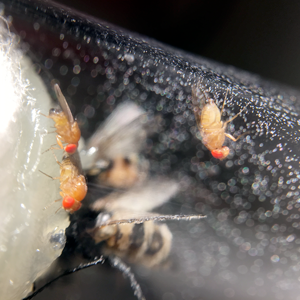Contact
 Paul Becher
Paul Becher
Researcher at the Department of Plant Protection Biology

Insect pests use chemical signals (semiochemicals) to find food, hosts and mates. Accordingly, chemical communication can be used as a target for pest control. The application of semiochemicals generally is considered as sustainable and environmentally safe. Control techniques like monitoring, attract-and-kill, mating disruption or push-pull exploit primarily pheromones or plant signals.
In addition, microbes emit chemical signals or modify plant and insect signals. Our research aims at developing microbial signals to complement existing control methods.
Fermentation odors produced by yeasts are strong attractants for insects of different families. Interestingly, we find species-specific associations between yeasts and insects that are reflected in a highly specific attraction to the respective yeast odors. We study the ecological relevance of the interaction to target different insect behaviors. Especially for horticultural pests, specific yeasts growing on fruit might indicate suitable oviposition of feeding-sites which allows to target egg-laying or foraging behavior, respectively.
Microbes might profit from attracting insects by using them as transporters to new plant substrates. Moreover, insect pathogenic microbes might use volatiles to attract and infect their hosts. Thus, attracting the host not only mediates infection but also autodissemination of the pathogen within the insect population.
Plant-associated microorganisms are known to affect plant growth positively or negatively. A changing release of plant volatiles in response to plant growth or plant health thus encodes valuable information for insects searching e.g. for host plants. The chemical communication underlying such multitrophic interactions are not understood but it is important to evaluate microbe-mediated direct effect on plant growth together with the indirect consequences for plant herbivores like pest insects, or beneficial insects.
We study the production, identity and reception of chemical compounds to understand their ecological meaning at a range from intraspecific to interkingdom communication. Understanding the underlying mechanisms of chemical communication provides the basis for development of new biocontrol tools.
 Paul Becher
Paul BecherResearcher at the Department of Plant Protection Biology